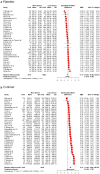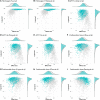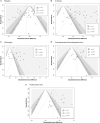Meta-Analysis and Systematic Review of Coagulation Disbalances in COVID-19: 41 Studies and 17,601 Patients
- PMID: 35360017
- PMCID: PMC8962835
- DOI: 10.3389/fcvm.2022.794092
Meta-Analysis and Systematic Review of Coagulation Disbalances in COVID-19: 41 Studies and 17,601 Patients
Abstract
Introduction: Coagulation parameters are important determinants for COVID-19 infection. We conducted meta-analysis to assess the association between early hemostatic parameters and infection severity.
Methods: Electronic search was made for papers that addressed clinical characteristics of COVID-19 patients and disease severity. Results were filtered using exclusion and inclusion criteria and then pooled into a meta-analysis to estimate the standardized mean difference (SMD) with 95% confidence interval (CI) for D-dimers, fibrinogen, prothrombin time, platelet count (PLT), activated partial thromboplastin time. To explore the heterogeneity and robustness of our fundings, sensitivity and subgroup analyses were conducted. Publication bias was assessed with contour-enhanced funnel plots and Egger's test by linear regression. Coagulation parameters data from retrospective cohort study of 451 patients with COVID-19 at National Research Center for Cardiac Surgery were included in meta-analysis of published studies.
Results: Overall, 41 original studies (17,601 patients) on SARS-CoV-2 were included. For the two groups of patients, stratified by severity, we identified that D-dimers, fibrinogen, activated partial thromboplastin time, and prothrombin time were significantly higher in the severe group [SMD 0.6985 with 95%CI (0.5155; 0.8815); SMD 0.661 with 95%CI (0.3387; 0.9833); SMD 0.2683 with 95%CI (0.1357; 0.4009); SMD 0.284 with 95%CI (0.1472; 0.4208)]. In contrast, PLT was significantly lower in patients with more severe cases of COVID-19 [SMD -0.1684 with 95%CI (-0.2826; -0.0542)]. Neither the analysis by the leave-one-out method nor the influence diagnostic have identified studies that solely cause significant change in the effect size estimates. Subgroup analysis showed no significant difference between articles originated from different countries but revealed that severity assessment criteria might have influence over estimated effect sizes for platelets and D-dimers. Contour-enhanced funnel plots and the Egger's test for D-dimers and fibrinogen revealed significant asymmetry that might be a sign of publication bias.
Conclusions: The hemostatic laboratory parameters, with exception of platelets, are significantly elevated in patients with severe COVID-19. The two variables with strongest association to disease severity were D-dimers and fibrinogen levels. Future research should aim outside conventional coagulation tests and include analysis of clotting formation and platelet/platelet progenitors characteristics.
Keywords: COVID-19; D-dimers; coagulopathy; fibrinogen; megakaryocyte; platelets; prothrombin time; thrombosis.
Copyright © 2022 Len, Iskakova, Sautbayeva, Kussanova, Tauekelova, Sugralimova, Dautbaeva, Abdieva, Ponomarev, Tikhonov, Bekbossynova and Barteneva.
Conflict of interest statement
The authors declare that the research was conducted in the absence of any commercial or financial relationships that could be construed as a potential conflict of interest.
Figures







Similar articles
-
The association between mortality due to COVID-19 and coagulative parameters: a systematic review and meta-analysis study.BMC Infect Dis. 2024 Dec 2;24(1):1373. doi: 10.1186/s12879-024-10229-y. BMC Infect Dis. 2024. PMID: 39623325 Free PMC article.
-
Hemostatic Changes in Patients with COVID-19: A Meta-Analysis with Meta-Regressions.J Clin Med. 2020 Jul 15;9(7):2244. doi: 10.3390/jcm9072244. J Clin Med. 2020. PMID: 32679766 Free PMC article.
-
Meta-analysis of coagulation parameters associated with disease severity and poor prognosis of COVID-19.Int J Infect Dis. 2020 Nov;100:441-448. doi: 10.1016/j.ijid.2020.09.021. Epub 2020 Sep 15. Int J Infect Dis. 2020. PMID: 32947052 Free PMC article.
-
Coagulopathy in patients with COVID-19: a systematic review and meta-analysis.Aging (Albany NY). 2020 Nov 24;12(24):24535-24551. doi: 10.18632/aging.104138. Epub 2020 Nov 24. Aging (Albany NY). 2020. PMID: 33229625 Free PMC article.
-
Clinical laboratory parameters and fatality of Severe fever with thrombocytopenia syndrome patients: A systematic review and meta-analysis.PLoS Negl Trop Dis. 2022 Jun 17;16(6):e0010489. doi: 10.1371/journal.pntd.0010489. eCollection 2022 Jun. PLoS Negl Trop Dis. 2022. PMID: 35714138 Free PMC article.
Cited by
-
The association between mortality due to COVID-19 and coagulative parameters: a systematic review and meta-analysis study.BMC Infect Dis. 2024 Dec 2;24(1):1373. doi: 10.1186/s12879-024-10229-y. BMC Infect Dis. 2024. PMID: 39623325 Free PMC article.
-
Beyond the Acute Phase: Long-Term Impact of COVID-19 on Functional Capacity and Prothrombotic Risk-A Pilot Study.Medicina (Kaunas). 2023 Dec 27;60(1):51. doi: 10.3390/medicina60010051. Medicina (Kaunas). 2023. PMID: 38256314 Free PMC article.
-
Coagulopathy and adverse outcomes in hospitalized patients with COVID-19: results from the NOR-Solidarity trial.Res Pract Thromb Haemost. 2023 Dec 7;8(1):102289. doi: 10.1016/j.rpth.2023.102289. eCollection 2024 Jan. Res Pract Thromb Haemost. 2023. PMID: 38292350 Free PMC article.
-
Hematologic tests and their association with the severity of COVID-19 and periodontitis in hospitalized patients: a case-control study.BMC Oral Health. 2023 Jul 11;23(1):473. doi: 10.1186/s12903-023-03208-3. BMC Oral Health. 2023. PMID: 37434176 Free PMC article.
-
Coagulation biomarkers and coronavirus disease 2019 phenotyping: a prospective cohort study.Thromb J. 2023 Jul 28;21(1):80. doi: 10.1186/s12959-023-00524-0. Thromb J. 2023. PMID: 37507773 Free PMC article.
References
-
- Johns Hopkins University Medicine . The Johns Hopkins Coronavirus Resource Center (CRC). Johns Hopkins University and Medicine (2021). Available online at: https://coronavirus.jhu.edu/ (accessed September 30, 2021).
LinkOut - more resources
Full Text Sources
Miscellaneous

